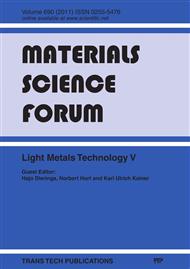p.274
p.278
p.282
p.286
p.290
p.294
p.298
p.302
p.306
Investigation of the Fatigue Behavior of AlMg4.5Mn (EN AW-5083) in the Temperature Range -60 °C < T < 20 °C
Abstract:
Stress-controlled load increase and constant amplitude tests have been carried out in a temperature range of -60°C < T < 20°C at the aluminium alloy AlMg4.5Mn (EN AW-5083). Therefore a recently developed climate chamber which operates with liquid nitrogen was mounted on a servo-hydraulic fatigue testing machine to realize the required low temperatures. Beside conventional mechanical hysteresis measurements, electrical resistance and temperature measurements are used to characterize the fatigue behavior. Furthermore, with these methods, the endurance limit was successfully estimated in a load increase test. Woehler curves were determined with constant amplitude tests at different temperatures. The conventionally determined endurance limit corresponds with the value from the load increase test.
Info:
Periodical:
Pages:
290-293
Citation:
Online since:
June 2011
Authors:
Price:
Сopyright:
© 2011 Trans Tech Publications Ltd. All Rights Reserved
Share:
Citation:


